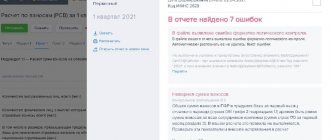Individual entrepreneur – VAT
In accordance with paragraph 1 of stat. 163 of the Tax Code, an individual entrepreneur is a VAT payer on the same basis as ordinary enterprises. That is, value added tax is equally applied by both individual entrepreneurs and legal entities when selling goods or services. For example, if the cost of a product is 100 rubles, upon sale it is necessary to add VAT on top at a rate of 18 or 10%, depending on what exactly the entrepreneur sells (produces) (stat. 164).
Taxation of individual entrepreneurs with VAT depends on what regime the business is in. Some special tax systems provide entrepreneurs with the opportunity to legally reduce the fiscal burden by replacing a number of taxes with the payment of a single one, levied under UTII, simplified tax system, unified agricultural tax or patent. Let's consider whether the individual entrepreneur pays VAT under the simplified tax system or other special tax regimes.
What should banks do?
The Central Bank instructs banks a weekly basis to determine the ratio of the amount of funds received into clients’ bank accounts, including VAT, and funds debited from clients’ bank accounts, excluding VAT.
If all receipts to the client’s account include VAT, and all write-offs do not include VAT, then the amount of VAT payable to the budget should be:
10% of debit turnover on transactions taxed at a VAT rate of 10%;
18% of debit turnover for transactions taxed at the VAT rate of 18%;
from 10% to 18% of debit turnover for transactions taxed at different VAT rates.
| Receipts to the account with VAT | Account debits without VAT | VAT rate | Share of VAT payable to the budget (in % of account turnover) |
| 100% | 100% | 10% | 10% |
| 18% | 18% | ||
| 10% and 18% | from 10 to 18% |
VAT for individual entrepreneurs under the simplified tax system
According to paragraph 3 of Art. 346.11 all entrepreneurs using the simplification are exempt from the obligation to pay VAT. The same applies to those businessmen who work on imputation (clause 4 of stat. 346.26), patent (clause 11 of stat. 346.43), agricultural tax (clause 3 of stat. 346.1). However, this statement is true in general cases, but some individual situations require the calculation and payment of value added tax even by entrepreneurs. In particular, VAT for individual entrepreneurs on simplified and other special regimes arises when:
- Import of products.
- Issuing an invoice to your customers with the allocated tax amount.
- Payment of rental services to owners of municipal or state property.
- Carrying out business transactions under agreements of joint activity, simple partnership, trust management and others according to Stat. 174.1.
- In a number of other cases, in accordance with legislative norms.
Manual - to help
The Central Bank has developed Methodological Recommendations on approaches to managing the risk of legalization (laundering) of proceeds from crime and the financing of terrorism by credit institutions No. 5-MR dated February 16, 2018.
The purpose of the manual is to help banks identify clients with questionable transactions. We are talking about those who launder proceeds from crime, do not pay taxes and customs duties, and withdraw funds from the Russian Federation.
The assessment of clients' activities will be carried out using the criterion of payment of taxes, in particular VAT.
What does it mean? Banks need to identify clients on whose accounts taxes are not paid or are paid in insignificant amounts that are not comparable to the scale of activity of the account holder.
When compiling the manual, the Central Bank was guided both by the results of its supervisory activities and by the information received as part of information interaction with the Federal Tax Service.
VAT for individual entrepreneurs under OSNO
When conducting commercial activities under the general regime, all entrepreneurs are considered VAT payers. In practice, this means that individual entrepreneurs will have to issue invoices, fill out a declaration and pay taxes to the budget. At the same time, OSNO automatically arises for those individual entrepreneurs who have not submitted an application to switch to one or another special regime; have lost the right to use it or are conducting several types of activities, including on the common system.
Exemption from VAT for individual entrepreneurs on OSNO is possible in the following situations:
- If an individual entrepreneur carries out non-taxable transactions, the declaration is submitted with the formation of section. 7.
- If an individual entrepreneur is exempt from the obligation to calculate VAT according to stat. 145 – reporting is not required to be submitted to the Federal Tax Service.
Who will they start with?
At the initial stage of applying these methodological recommendations, the Central Bank invites banks to pay increased attention to those transactions on the client’s account, in which the share of payments related to the crediting of funds with VAT in the total volume of funds credited to the client’s bank account is more than 70%, and the share payments related to the write-off of funds with VAT is less than 30% of the total amount of funds written off from the client’s bank account.
| Receipts from VAT in total receipts | VAT write-offs in total write-offs | |
| When you are guaranteed increased attention from the bank | 70% | 30% |
In the future, when analyzing payments including VAT and excluding VAT on the client’s bank accounts, the credit institution can change the ratio of such payments taking into account the client’s risk assessment , the scale and nature of its activities.
Individual entrepreneur for VAT - what reports to submit
The main type of reporting for individual entrepreneurs for VAT is a tax return. The form is submitted for tax periods, which are set to one quarter (Article 163). The method of presentation is electronic. The deadline for submission is the 25th day of the month following the reporting month. Is there a zero VAT return for individual entrepreneurs? This is possible if the entrepreneur is a VAT payer, but for some reason did not conduct business. In this case, the individual entrepreneur is required to submit profit reports, as well as value added tax, to the control authorities in order to avoid fines for failure to submit declarations.
Suspicious transfers
The manual contains a list of transfers from customer accounts without VAT that are suspicious. Presumably, such payments are aimed at avoiding taxes.
Such payments include:
- transfers of funds to the accounts of branches of the Federal State Unitary Enterprise "Russian Post";
- transfers of funds to the accounts of paying agents and bank payment agents;
- transfers of funds by legal entities from their bank accounts to bank accounts of individuals, transactions for which are carried out using bank cards;
- transfers of funds to the accounts of persons engaged in tour operator and travel agency activities and other activities related to organizing travel (tourism activities).
What information should be on an invoice excluding VAT?
There are no special subtleties or difficulties here: the list of details in the invoice without VAT is exactly the same as in any invoice for payment:
- Supplier's name, tax identification number and address.
- Bank details of the supplier (usually they are provided in the form of a completed payment order - this is both clear and convenient for the buyer).
- The serial number of the account, its date.
- Buyer's name.
- Number of the agreement with the buyer (if any).
- Complete information about the service or product: name, quantity, unit of measurement, price, total cost.
- Positions, names and signatures of the manager and chief accountant of the supplier.
All details of the invoice for payment and the procedure for filling them out are discussed in detail in ConsultantPlus:
Get free access to K+ and go to the Ready Solution.
How to fill out the tabular part of an invoice without VAT (sample)
Let's look at a sample invoice for payment without VAT:
- In the first column, fill in the serial number (there will be as many numbers as there are different goods or services you are selling to the buyer).
- In the second column we indicate the unit of measurement.
- In the third column we enter the quantity.
- The fourth is the price.
- The fifth is the amount of the product or service.
Having thus filled in all the columns for each item, we complete the filling of the tabular part of the invoice by entering the total purchase amount in the “Total” line.
Next, under the table, we indicate the total cost in words and with the obligatory addition of the phrase “Without VAT” at the end of this entry.
And in order to increase the chances of your buyer correctly filling out the payment invoice (so that he does not confuse and accidentally highlight the amount of tax in it), we recommend that in the invoice for payment without VAT, you provide a sample of filling out not only your bank details, but also the purpose of the payment.
For the same purposes, appropriate notes can be made in the columns of the tabular part of the invoice “Price” and “Amount”. Then they will look like this: “Price (excluding VAT)”, “Amount (excluding VAT)”.
A sample of filling out an invoice that does not contain the tax amount is posted on our website.
What does “VAT exempt” mean?
Submit your VAT return using the Kontur.Accounting web service. The system itself will generate a declaration based on primary documents and check it before sending.
An extensive list of goods, works, services and transactions exempt from VAT is given in Article 149 of the Tax Code of the Russian Federation. Here are the operations exempt from tax (a number of operations from the list require a license; if an organization does not have one, it cannot apply tax exemption):
- sale or transfer for one’s own needs of religious literature and paraphernalia;
- banking operations performed by banks (except for collection);
- sale of folk arts and crafts;
- services of insurers and non-state pension funds;
- lotteries held by decision of government authorities;
- sale of industrial products containing precious metals, scrap and waste;
- sales of rough diamonds to processing enterprises;
- transfer of goods, property rights, provision of services within the framework of charity;
- sale of tickets and subscriptions by physical education and sports organizations;
- loan and repo transactions;
- other operations listed in clause 3 of Art. 149 of the Tax Code of the Russian Federation.
Here are the goods, works and services exempt from tax:
- medical, sanitary, cosmetic, veterinary services and goods;
- care services for the disabled, elderly and sick;
- child care and leisure services;
- funeral goods and services;
- food products produced by educational and medical institutions;
- transportation of the population;
- sale of postage stamps, envelopes, postcards and other postal products;
- warranty service of equipment;
- restoration and restoration of historical buildings, monuments and cultural objects;
- others listed in paragraph 2 of Art. 149 of the Tax Code of the Russian Federation.
Only companies that work in their own interests and not in the interests of others under agency agreements, commission or commission agreements have a chance to be exempt from VAT. Another important condition is to separate and separately account for taxable and non-taxable transactions.
Which is correct: “without VAT” or “not subject to VAT” and what is the difference
The author of the article is Copywriter Kontur.Accounting
Kontur.Accounting - cloud accounting for business!
Quick establishment of primary accounts, automatic tax calculation, online reporting, electronic document management, free updates and technical support.
When working with contracts, you can come across the notes “excluding VAT” and “VAT not subject to” when determining the contract price, shipping documents, and invoices. In this article we will tell you the difference between “Without VAT” and “Not subject to VAT” and what wording to indicate in the documents.
What documents to collect to obtain VAT exemption
Organizations and entrepreneurs seeking to avoid paying tax, under the terms of Art. 145 of the Tax Code of the Russian Federation submit tax documents:
- notification of the exercise of the right to tax exemption;
- extract from the balance sheet and data from the financial results report;
- extract from the accounting book (for individual entrepreneurs);
- extract from the sales book.
Prepare and send a set of documents to the tax office by the 20th day of the month in which the benefit began to be applied. You can use the benefit received for at least a year, unless the conditions are violated.
Working without VAT has many advantages: there is no need to calculate and pay tax, prepare a declaration and fill out a purchase book. But at the same time, working without tax may be unprofitable, because when concluding an agreement with an organization that does not pay VAT, the buyer will not be able to receive a deduction, so many counterparties choose companies that pay tax in the general manner.




